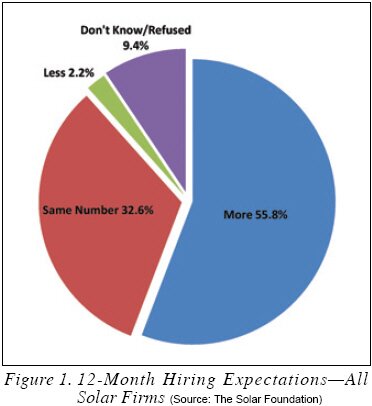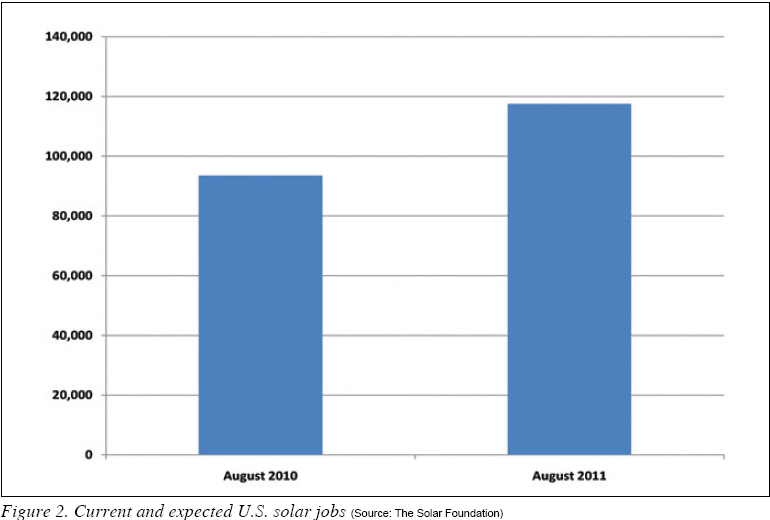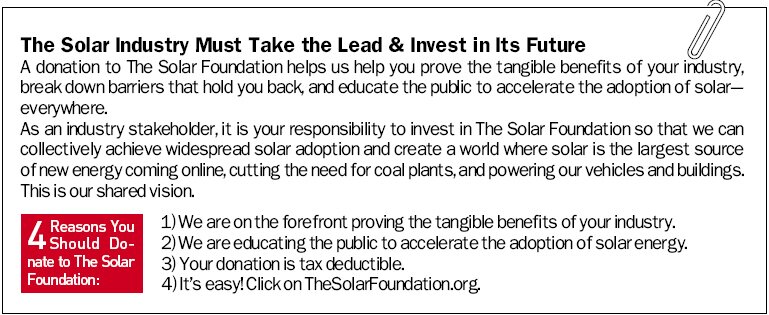First-ever U.S. Solar Jobs Census finds solar is a bright spot in America’s economy.
The first-ever U.S. solar jobs census proves that solar is having a positive and substantial impact on the U.S. economy. The Solar Foundation’s National Solar Jobs Census 2010 identified more than 93,000 solar jobs nationwide. It also found that solar employers expect to increase the number of solar workers by 26%, representing nearly 24,000 net new jobs, by August, 2011. This rate is significantly higher than the expected 3% net job loss in fossil fuel power generation and the economy-wide expectation of two percent growth over the same period.
By Andrea Luecke

 It’s no secret that high unemployment and job creation are some of the biggest issues for Americans today. A Gallup Poll issued in September of this year found that unemployment far outpaces all other issues when Americans were asked to name the most important problem facing the country. Close to 15 million Americans are out of work and sectors such as healthcare and information technology are creating jobs at a glacial pace, while the arts, entertainment and recreation sectors are cutting jobs. Every day the news is peppered with tragic stories about furloughs, layoffs, and outsourcing. The results of this year’s U.S. congressional elections confirm that millions of Americans are desperate for job security and some good news. It’s no secret that high unemployment and job creation are some of the biggest issues for Americans today. A Gallup Poll issued in September of this year found that unemployment far outpaces all other issues when Americans were asked to name the most important problem facing the country. Close to 15 million Americans are out of work and sectors such as healthcare and information technology are creating jobs at a glacial pace, while the arts, entertainment and recreation sectors are cutting jobs. Every day the news is peppered with tragic stories about furloughs, layoffs, and outsourcing. The results of this year’s U.S. congressional elections confirm that millions of Americans are desperate for job security and some good news.
The solar industry is one such bright-spot. The U.S. has some of the best solar resources in the world and the majority of Americans already recognize this. According to the 2010 Schott Solar BarometerTM, 94% of Americans support greater use of solar and 80% want to shift subsidies away from fossil fuels to solar. As a result, the solar industry is gaining traction. Although solar still represents only a small share of our overall energy use, installed capacity is poised to double this year. Within the last four years, solar in the U.S. went from a US$1.5 billion industry to a US$6 billion industry.
With this investment and growth, jobs should follow, right? We thought so, but because the U.S. Bureau of Labor Statistics does not measure solar jobs and analysts in the past have relied on jobs-per-dollar or jobs-per-megawatt assumptions, measurements have not been accurate enough to know what impact on job creation investment and growth have had. This has fed suspicions that solar jobs or green jobs are a myth. The unprecedented National Solar Jobs Census, produced by The Solar Foundation, helps put those suspicions to rest.
The Solar Foundation, a national solar focused 501(c)(3) nonprofit, recognized that without concrete job creation numbers, the solar industry is handicapped during policy debates focused on economic impact. As a result, The Solar Foundation decided to author the National Solar Jobs Census that, for the first time, establishes a credible solar jobs baseline, by accurately quantifying solar jobs across the entire value chain, and projects with certainty solar job growth over the next 12 months.
The methodology was developed by The Solar Foundation and Green LMI, a labor market research firm, in partnership with Cornell University’s School of Industrial and Labor Relations. In an effort to ensure both a high and statistically significant response rate, we repeatedly contacted known (or self-identified) solar employers as well as employers in industry classifications that are most likely to have solar employees. In census terms, our 29% response rate from known solar employers is considered very high. The overall responses were, then, compiled and our findings were cross referenced with several dozen secondary data sets to ensure accuracy.
 The results of the census were impressive and surprising. We found that solar jobs in America are on the rise and that over half of all solar employers plan to create new jobs over the next year (Figure 1). Our census identified approximately 93,000 solar workers nationwide and revealed that solar is creating jobs at a 26% job growth rate (Figure 2), a much faster pace than the 2% job growth rate for the overall economy and the 3% job loss rate for the fossil fuels industry. The results of the census were impressive and surprising. We found that solar jobs in America are on the rise and that over half of all solar employers plan to create new jobs over the next year (Figure 1). Our census identified approximately 93,000 solar workers nationwide and revealed that solar is creating jobs at a 26% job growth rate (Figure 2), a much faster pace than the 2% job growth rate for the overall economy and the 3% job loss rate for the fossil fuels industry.
Furthermore, we found that job growth is not confined to the sunniest regions of the country. The census reveals job growth in all regions--the Western states (especially California) contain the majority of the solar jobs, followed by the Northeast/Mid-Atlantic Region. Although our census was designed to be a snapshot of the national solar industry’s size, scope and potential for growth, we also included some state-level data. For states such as Colorado, Arizona, Wisconsin, and California, it provides lawmakers with tangible proof, not projections, that the solar industry is creating jobs in their states and should be supported.
In other states, the census had a different effect. For states such as Michigan, Minnesota, Illinois, New Jersey, and Ohio, it reinforced the need for greater participation among survey respondents. The failure of one large solar employer to respond to the census, for example, can have an adverse effect on overall state numbers. Thus, the census has become a catalyst for solar employers in every state to stand up and be counted.

The diversity of the solar industry and its value chain was also highlighted in the census. Of the 31 distinct occupations that were analyzed, installer and electrician jobs are the fastest growing: 58 and 47% respectively. However, there is growth with all other occupations including sales, roofing, assembly, legal, and administration, proving that solar jobs represent an opportunity for Americans with varying levels of skill, education, and experience. Interestingly, employers that responded to our census reported difficulty hiring qualified workers. This may be due to the fact that solar jobs are opening up so fast that employers find it burdensome to integrate so many new employees at once or that some of the jobs require specialized training.
The results of the census also give hope to America’s sagging manufacturing sector, which has dipped below pre-World War II employment levels. Solar is playing a part in the resurgence of American manufacturing. Our census found that solar manufacturing firms are expected to grow 36% over the next 12 months, with two-thirds of all firms expecting to hire and none expecting to cut workers. There have been a number of high-profile plant expansions and new facilities being built by companies like Abound Solar, Dow Chemical Company, Hemlock Semiconductor LLC, Helios USA, Suntech, Kyocera, and First Solar. And other firms from different sectors have repurposed their facilities to enter the solar supply chain. Companies that specialize in tanks, valves, piping, or stamped metal products can break into the solar water heating industry with minor adjustments. Similarly, companies that manufacture glass or silicon can be repurposed for PV. Cardinal, AGC, National Semiconductor, and Applied Materials are just a few examples of resourceful companies that have found productive ways to disassociate themselves from mature or increasingly obsolete markets. In the end, lowered transportation costs, combined with an increased demand for solar, make the U.S. an ideal location for solar manufacturing to continue to flourish. And it certainly doesn’s hurt that the president of First Solar has been appointed chair of President Obama’s U.S. Manufacturing Council.
However, it is important to remember that these solar jobs did not spring up overnight. They are the result of new financing opportunities, cost reductions in manufacturing and installation, state and local sustainability goals, and smart federal policies. This growth occurred despite the fossil fuel industry receiving US$5 in government subsidies for every US$1 that solar receives. The notion of smart federal policies becomes even more critical when you consider that solar employs many more people per kWh than the coal industry, which has become increasingly automated. Thus, it is essential that federal policies such as the Treasury Grant Program, the DOE loan guarantees, and domestic manufacturing incentives continue. If these smart federal policies that have contributed to a workforce of over 93,000 people are allowed to lapse, much of the solar industry’s momentum will be halted.
In sum, our census found that the solar industry is creating good, stable, full-time jobs along the entire value chain in every region in the country, which, in this economy, is not the case across other sectors. It tangibly demonstrates how solar is helping thousands of families not only weather the recession in the United States, but succeed. Solar is ready now as a clean, reliable source of energy and is having a beneficial and substantial impact on the overall U.S. economy. Based on the positive response the census has received upon its release, it is clear that there is a strong appetite for data that provides clear indications of the solar industry’s value.
Moving forward, we will continue discussions with the U.S. Bureau of Labor Statistics to help define a solar job category so that solar may be included in future Bureau reports. But to more fully understand state-level solar labor markets, more detailed state-by-state data collection, research, and analysis is needed. In an effort to fine-tune our work and to provide the industry with even more tools to advocate for favorable solar policies, we plan to conduct annual updates and delve more deeply into state and regional data. Currently, we are seeking collaborative partnerships to finance these important studies.
Employment data will continue to be essential in showing policy makers that solar is creating a clean, secure energy economy that supports local economic development. But we cannot arm policy makers with the information they need without complete and enthusiastic support from the entire solar industry. Positive industry-wide news, such as this census, benefits you and your business by strengthening support for the smart policies the solar industry needs to maintain its robust growth in the U.S. In the end, a strong and stable policy environment is what will drive the long-term growth of the industry.

Andrea Luecke is the acting executive director of The Solar Foundation (www. thesolarfoundation.org), where she is responsible for developing and implementing educational initiatives and research that promote the widespread adoption of solar energy. In addition to the release of the National Solar Jobs Census 2010 report, The Solar Foundation is a partner on the U.S. Department of Energy Solar America Communities Outreach grant to provide local governments across the country with technical expertise in creating solar programs and policies. Prior to joining the Foundation, Luecke led the City of Milwaukee’s U.S. Department of Energy Solar America Cities program and spearheaded the Milwaukee Metro Solar Hot Water Business Council, helping local manufacturers enter the high-growth solar market.
For more information, please send your e-mails to pved@infothe.com.
ⓒ2010 www.interpv.net All rights reserved. |


